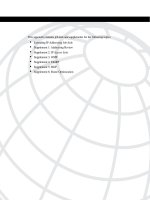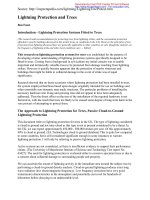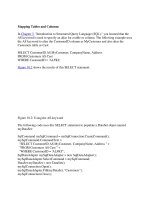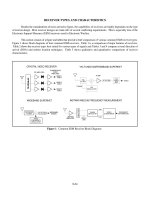Tài liệu Burning CDs and DVDs doc
Bạn đang xem bản rút gọn của tài liệu. Xem và tải ngay bản đầy đủ của tài liệu tại đây (35.56 KB, 7 trang )
11.2. Burning CDs and DVDs
Who misses the floppy drive anymore? A blank CD holds at least 450 times as many
files, and a blank DVD holds about 3,250 times as many!
You can buy blank CDs incredibly cheaply in bulk—$20for100discs, for example—via
the Web. (To find the best prices, visit www.shopper.com
or www.buy.com and search
for blank CD-R.) Blank DVDs are only slightly more expensive—about $30 for 100.
Burning a CD or DVD is great for backing stuff up, transferring stuff to another computer
(even a Windows PC), mailing to somebody, or offloading (archiving) older files to free
up hard drive space.
You can burn a disc in either of two ways: with the blank disc inserted or without.
11.2.1. Burn Folders: Without the Disc
The burn folder is a special folder that you fill up by dragging file and folder icons to it.
Then, when you're ready to burn, you just insert the blank disc and go.
UP TO SPEED
Mac OS Extended Formatting
Whether you use Disk Utility to erase a disk (or when you first install Mac OS
X and elect to erase the hard drive in the process), you'll be confronted with a
choice between formatting options called Mac OS Extended and UNIX File
System (UFS). (Depending on the kind of disk, you may also see an option to
create a DOS-formatted disk for use in Windows machines.)
Mac OS Extended or Mac OS Extended (Journaled) refers to the HFS Plus
filing system, a disk format that has been proudly maximizing disk space for
Mac fans since Mac OS 8.1. (For a definition of journaling, see Section A.6.)
Mac OS X still accepts disks that were prepared using the older, Mac OS
Standard formatting—the ancient HFS (hierarchical filing system) format—but
you can't use one as your startup disk, and any file names longer than 31
characters will appear chopped-off.
As for the UNIX File System option, it's exclusively for use on computers that
run Unix (the pure variety, not the dressed-up version that is Mac OS X).
The burn-folder concept has a lot going for it:
•
No wasted hard drive space. Using the old system of burning discs, you inserted
the blank and then dragged files and folders onto its icon. The Mac duplicated
each item, parking it in an invisible, temporary holding area until you were ready
to burn.
Trouble is, you were therefore doubling the disk-space requirement of the files
you intended to burn. If you were burning a DVD to get older files off your hard
drive because you were running low on space, you found yourself with a Catch-
22. You couldn't free up drive space without burning a DVD first—but you didn't
have enough drive space to burn a DVD!
If you use a burn folder instead, the Mac just sets aside aliases of the files and
folders you want to burn. Aliases take up negligible hard drive space. When you
finally burn the disc, the designated material is copied directly onto the CD or
DVD.
•
Easy reuse. You can keep a burn folder on your desktop, prestocked with the
folders you like to back up. Each time you burn a disc, you get the latest version of
those folders' contents, and you're saved the effort of having to gather them each
time.
•
Prepare ahead of time. You can get a CD or DVD ready to burn without having a
blank disc on hand.
Here's how you use burn folders:
1. Create a burn folder.
To make a burn folder appear on your desktop, choose File New Burn Folder.
To create one in any other window, Control-click (or right-click) a blank spot
inside that window and, from the shortcut menu, choose New Burn Folder.
Either way, a new folder appears, bearing the universal Mac radioactive "burn"
symbol (Figure 11-3
).
2. Rename it.
Its name is highlighted, so you can just start typing to rename it. Press Enter when
you're finished.
3. Load up the folder by dragging files and folders onto it.
If you double-click the burn folder to open its window (Figure 11-3), you'll notice
that you're not actually copying huge files. You're simply making a list of aliases.
Tip: To check how many megabytes' worth of stuff you've added so far—so you
don't overflow your CD or DVD—click the Burn button in the upper-right corner
of the burn folder's window. The resulting message, shown at bottom in Figure 11-
3, tells you the current total. (Hit the Enter key, or click Cancel, to close the dialog
box.)
4. Decorate the window, if you like.
You can choose list view or icon view; you can drag the icons into an arrangement
that you like; you can change the background color of the window; and so on. One
nice feature of the Mac (which is not available on The Other OS) is that the look
of a window is preserved when you burn it to CD.
5. Click the Burn button in the upper-right corner of the window, or choose File
Burn Disc.
Figure 11-3. Top: A burn folder looks like any ordinary folder—except that it
has that radioactive logo on it. You can drag files and folders right into its
window; Mac OS X displays only aliases for now, but when you burn the disc,
the actual files and folders will be there.
If you open the burn folder, you find an unusual strip across the top. Its most
important feature is the Burn button at the right.
Bottom: Ready to proceed, Captain.
6. Insert a blank disc.
If you have a slot-loading Mac, slip the disc into the slot. If your Mac has a sliding
CD/DVD tray instead, open it first by pressing the button on the tray, or pressing
your key for about one second.
Tip: Once you've inserted a CD or DVD into your tray, you can close it either by
pushing gently on the tray or by pressing the key again.
One last confirmation box appears, where you can name the disc and choose a
burning speed for it.
7. Click Burn (or press Enter).
The Mac's laser proceeds to record the CD or DVD, which can take some time.
Feel free to switch into another program and continue using your Mac. When it's
all over, you have a freshly minted CD or DVD, whose files and folders you can
open on any Mac or Windows PC.
11.2.2. Burn Folders: With a Blank Disc On Hand
If you have a blank disc ready to go, burn folders are even simpler to use. In fact, you
may not even be aware that you're using them. The whole operation requires fewer
steps—yet it still doesn't require the Mac to duplicate all the files you plan to burn.
Start by inserting a blank disc. After a moment, the Mac displays a dialog box asking, in
effect, what you want to do with this blank disc (unless you've fiddled with your
preference settings). See Figure 11-4
for instructions.
Figure 11-4. Top: Choose Open Finder if you plan to copy regular Mac files onto the
CD or DVD, or Open iTunes if you plan to burn a music CD using iTunes. (Click
"Make this action the default" if you figure you'll always answer this question the
same way.) Click OK.
Drag the disc onto the Burn icon in the Dock, or choose File Burn Disc.
Bottom: Confirm your choice in this box.
If you choose Open Finder, you'll see the disc's icon appear on the desktop after a
moment; its icon also appears in the Sidebar, complete with a round Burn symbol that
looks like a radioactivity logo.
At this point, you can begin dragging files and folders onto the disc's icon, or (if you
double-click the icon) into its window. You can add, remove, reorganize, and rename the
files on it just as you would in any standard Finder window. All you're really doing is
dragging aliases around; the real files are left untouched on your hard drive. You can also
rename the CD or DVD itself just as you would a file or folder (Section 2.2
).
Tip: The status bar at the bottom of the window gives you a running tally of the disk
space you've filled up so far. (It may say, for example, "223.2 MB of 702.8 used on
disc.") At last, you have an effortless way to exploit the blank disc's capacity with
precision.
When the disk contains the files and folders you want to immortalize, do one of these
things:
•
Choose File Burn Disc.
•
Click the Burn button next to the disc's name in the Sidebar.
•
Drag the disc's icon toward the Trash icon in the Dock. As soon as you begin to
drag, the Trash icon turns into that yellow fallout-shelter logo. Drop the disc's icon
onto it.
(For some reason, the Burn Disc command no longer appears in the shortcut menu when
you Control-click or right-click the disc's icon—at least not in 10.5.1.)
In any case, the dialog box shown at bottom left in Figure 11-4
now appears. Click Burn.
When the recording process is over, you'll have yourself a DVD or CD that works in any
other Mac or PC.
Here are a few final notes on burning CDs and DVDs at the desktop:
•
Not sure what kinds ofdisks your Mac can burn? Open System Profiler (in your
Applications Utilities folder). Expand the Hardware triangle, and click the
Disc Burning category. There it is, plain as day: a list of the formats your machine
can read and write (that is, burn). For example, you might see: "CD-Write: -R, -
RW. DVD-Write: -R, -RW, +R, +RW."
•
In the Finder, you can only record an entire disc at once; you can't add any more
files after the first burn. There is a trick, however, that lets you add more to a
previously recorded CD-R or DVD-R if you use Disk Utility instead. (Technically,
you create a multisession disc.) See the box on the facing page.









